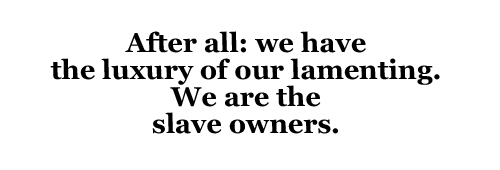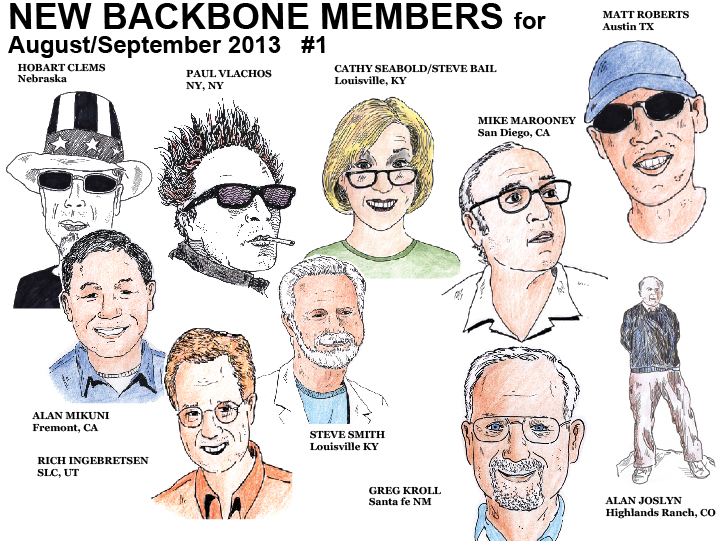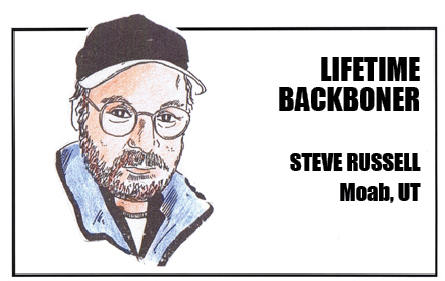It’s a cliché to say that every object has a story. But, when you’re a consummate thrift store and flea market browser, as Jim and I are, the truth is that each of our belongings probably has three or four stories. It is nice to remember, for instance, the day in Springfield, Colorado when I found the little Japanese fingerbowl that now sits on a small table in our kitchen. I know, from the “Made in Occupied Japan” stenciled on its bottom, that the bowl has seen far more interesting homes and times than mine. Other objects in our home speak to the passage of time, the altered economies of life in America. One favorite summer shirt, for example, has provoked my historical fascination lately:
A couple of years ago, Jim and I were driving through Eastern Kansas, on one of our drive-about prairie road trips. We had stopped for the night and were wandering around the sweetly preserved Victorian downtown when I noted a thrift store still open across the street. Jim, shrugging, crossed the street with me and followed me into the store. As these things often go with us, I was the one to point out the store and Jim was the one who had success once we were inside. He found a few little things we needed for the house, a belt, and two or three shirts. On top of that, he made instant friends with the older women behind the counter, and the three of them were chatting away about the history of the town, the charm of the Main Street, and the upcoming Tulip festival, while I perused the store unsuccessfully.
After looking through the racks for nearly a half hour, I found one item. The shirt, striped in red, blue and green, was a little more colorful than I usually like, but it was clearly well-made and the checked pattern and simple button-down style lent the garment a cheerful, vintage feeling which appealed to me. Plus, it was only a dollar and I didn’t want to play the unfriendly, stingy wife after Jim had charmed the store owners so completely. So I tossed the shirt on top of Jim’s pile.
It was the woman behind the counter who noticed the tag, as she was ringing up our total, and exclaimed, “My goodness, you hardly ever see these!” She held out the shirt to me, with a finger pointing to a circular label, under the manufacturer’s name and the washing instructions, which bore the insignia “ILGWU.” Around the circle, the text read, “ INT LADIES GARMENT WORKERS UNION.”
The woman continued talking. “ I can’t even remember when you stopped seeing these labels,” she said, “ but it’s certainly been a while.” She paused. “That’s sort of sad, isn’t it? But at least you know you’ve got a good shirt.” I agreed and, as we gathered our bags and left the store, we promised to pass through again sometime.
The shirt turned out to be as good as she promised, and it quickly became a favorite. One day this summer I looked up the ILGWU label online, and found that the shirt was made sometime between 1974 and 1995. After watching the union’s hilariously dated “Look for the Union Label” commercials (and, of course, the SNL Dope Grower’s Union commercial parody,)I began to read up on the sobering history of the International Ladies Garment Worker’s Union and, of course, the Triangle Shirtwaist Factory Fire of 1911. It made for depressing historical research, especially when you consider that this is the year when the Western world suddenly un-blinded itself to the conditions of workers in the clothing factories in Bangladesh, after a series of devastating fires and collapsed factory buildings.
Of course, it’s been a few months now since 1,129 people died in the Rana Plaza factory collapse in the industrial sector of Bangladesh’s capital city of Dhaka. And so most people have stopped wondering, as they ring up their purchases, whether that new dress was sewn by a woman who later died with a thousand others under eight stories of rubble.
I know a few Americans whose response to the horrific conditions in Bangladesh amounted to, “Well, I never shop at Walmart anyway.” Buried in the articles about the collapse, one finds that Walmart wasn’t the only culprit. Among many others, JC Penney’s, Sears, Joe Fresh, Gap, Benetton, and Disney had all subcontracted to the factories. In the media frenzy, many of the brands signed on to a new legally binding labor agreement, to ensure some improvement in the conditions for Bangladeshi workers, but Gap and Walmart notably abstained. In statements to the press, the companies claimed that they would enforce better labor conditions without the agreement, but cynical observers (myself included) wondered if these companies weren’t just waiting out the public scrutiny—knowing that the public attention span would soon tire of Bangladesh and move on to other stories.
Per usual, we cynics were right. The public fury died down almost immediately, once the companies in question had issued their requisite apologies. Despite months of protests, the wages paid to workers remain half of what their sweatshop compatriots earn in Cambodia, and even less than workers in Pakistan, Vietnam and China. Compared to the Bangladeshi workers, Chinese sweatshop laborers, with an average hourly wage of $1.26, seem practically overpaid.
Meanwhile, despite the “legally binding” labor agreement signed by retailers, the BBC found recently that factory conditions remain fatally substandard. According to “The Independent” newspaper:
“The BBC’s Panorama programme found staff making clothes for the cut-price retailer Lidl, some reportedly working 19-hour days – and even being locked inside the factory. According to the investigation, in the past 10 months there have been more than 50 factory fires, with many workers killed because the gates have been locked and they have been unable to escape.
Panorama secretly filmed a security guard locking the front gate. One worker, who had earned around £2 for his 19-hour day, said he had to be back at the factory in four hours. ‘My feelings are bad and my health is too. In the last two weeks, approximately, it has been like this for eight nights,’ he said.”
These conditions persist because no one steps in to stop them. The factory owners are making a profit; the contractors are making a profit; the retailers are making a profit. And the consumers, cowed by their own low wages and accustomed to cheap clothing, will gladly look the other way. After all, unlike the Triangle Shirtwaist Fire, when these women leap out eight-story windows to escape the flames, their bodies fall on the streets of Dhaka, and not on the streets of New York.
The only humor in this situation is dark humor. Reading one article about the increased inspections of WalMart factories, I found this gem:
The Bangladeshi press reported in January that Walmart had refused a shipment of women’s shorts from Simco after discovering unauthorized subcontracting to Tazreen Fashion, where a fire killed 117 people last year. Simco said at the time that Walmart’s ban could drive it into bankruptcy…
Siddique contended that Walmart’s listing of his company is unfair and is damaging his family’s business. After the list was published, he said J.C. Penney canceled a $300,000 order for 500,000 pairs of pajamas.
Consider the math of this economic exchange. $300,000 for 500,000 pairs of pajamas. That’s 60 cents per pair. And therein lies the sham of the American economy. What portion of that 60 cents do you think a Bangladeshi worker receives? Considering their average hourly pay is 24 cents, I’d say very little. But Siddique’s spokesperson didn’t feel any shame in admitting the criminally low wholesale price of their products. And J.C. Penney doesn’t seem ashamed to admit the criminally low prices it pays for its goods. And why should they be ashamed? Everyone makes a bang-up profit in such a system, save for the poor laborer at the bottom of the economic food chain.
There are only simple arguments in the conversation about labor conditions and fair wages. The retailers say that they are simply providing a service–that their consumers demand low prices and that those consumers will shop elsewhere if the store’s prices can’t compete. These retailers are giving low-income Americans access to the goods they need to survive. Who would fault them for that?
The simple argument of the consumer is that times are hard for everyone. Yes, we sympathize with those poor people who died, but who can afford to buy ethically-made products on today’s wages?
And the government simply can’t be bothered. After all, this system is great for Americans. What else is there?
There is, of course, morality. One voice of moral clarity, which rang out in the weeks after the terrible factory collapse, was that of Pope Francis, who called the system what it is: slavery. “Living on 38 euros ($50) a month – that was the pay of these people who died. That is called slave labor,” Francis said.
“Not paying a just wage, not giving work, only because one is looking at the bottom line, at the budget of the company, seeking only profit – that is against God”.
It is easy to throw up your hands in the face of such an intrenched injustice. After all, the world economy was based in slavery for thousands of years before the Enlightenment and the rise of the middle class brought moral considerations to the forefront. Even after our Civil War, much of the population lived in virtual wage slavery well into the 1900s, thanks to sharecropping and sweatshops like the Triangle Shirtwaist factory. Maybe those brief decades of American labor between the 1930s and the 1990s, and union-label relics like my shirt, are the pipe dream. Those halcyon years were the anomaly; and a slave-and-master economy is the underlying human reality to which we must continually return. It’s a horrible argument, but it has a lazy appeal to those who don’t want to think very hard about how we got this way—those who might lament the world as it is, but don’t want to press too heavily on blame.
After all: we have the luxury of our lamenting. We are the slave owners.
“I would be a traitor to those poor burned bodies, if I were to come here to talk good fellowship. We have tried you good people of the public—and we have found you wanting…
This is not the first time girls have been burned alive in this city. Every week I must learn of the untimely death of one of my sister workers. Every year thousands of us are maimed. The life of men and women is so cheap and property is so sacred!”
—Rose Schneiderman, Polish-born former hat worker and employee of the Triangle Shirtwaist Factory.
To read the PDF version of this article, click here.
Don’t forget the Zephyr ads! All links are hot!













Great piece, Tonya. I pass the site of the Triangle Shirtwaist fire all the time. The plaque is high up on the building, it’s almost as though they wanted it out of sight, and I look at the oblivious pedestrians, mainly students, and think of those poor, young women leaping to their deaths. Thanks for the reminder. I may have to go play “Union Maid,” by the glorious Mr Guthrie, on my guitar.
Remember when you walked in Walmart and all the little flags were waving? They bragged long and hard that so many products were made in the USA. Seems like many, many years ago. Good luck finding anything made here now. Hard to say if we work for China or they work for us. There are pros and cons regarding Unions. They were vital at one time due to corrupt owners and dangerous conditions. Over decades they became their own enemy in some ways. I enjoyed the story of the shirt. I have a few articles of clothing that are like old friends. I have a dark blue Hawaiian style shirt with white sword fish on it. It won’t die. Every summer I whip it out and that day, summer begins again for me.
I swear by my Griffiths Enoch poncho — 100% Welsh wool, woven in Llanbedr, Gwynedd, and second-hand to boot. And they used the rest of the sheep for mutton. And when it was a wee lamb frolicking on the hills of Wales, it had a happy life. (But as for trousers, I transgress all the time. Tonya, you’ve called me to account.)